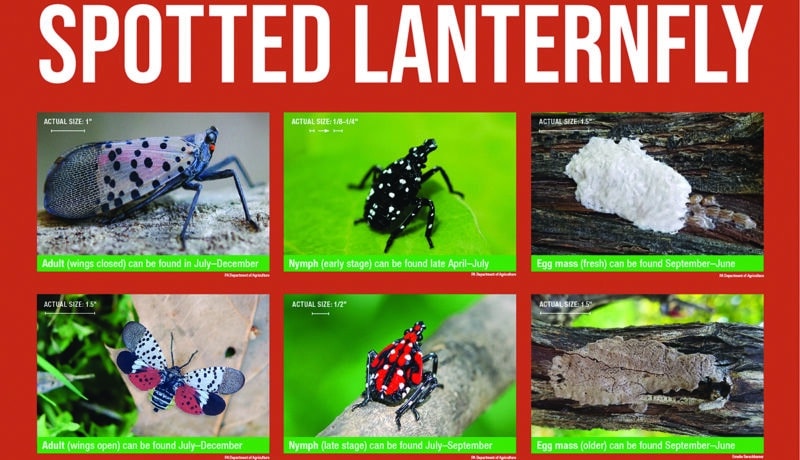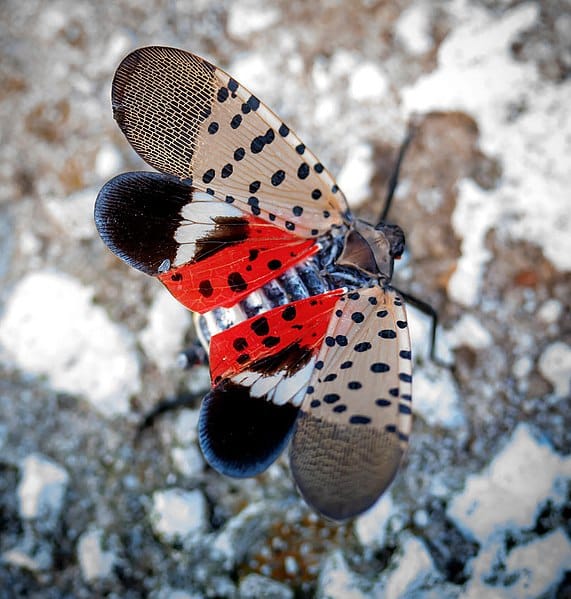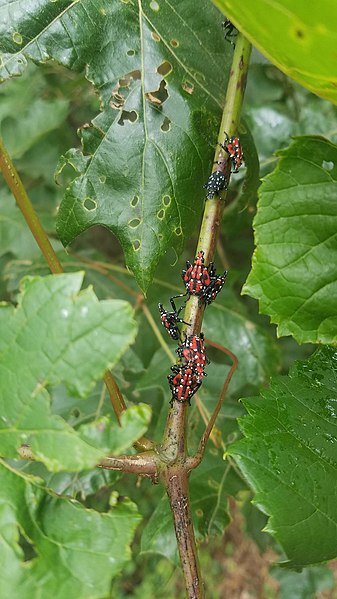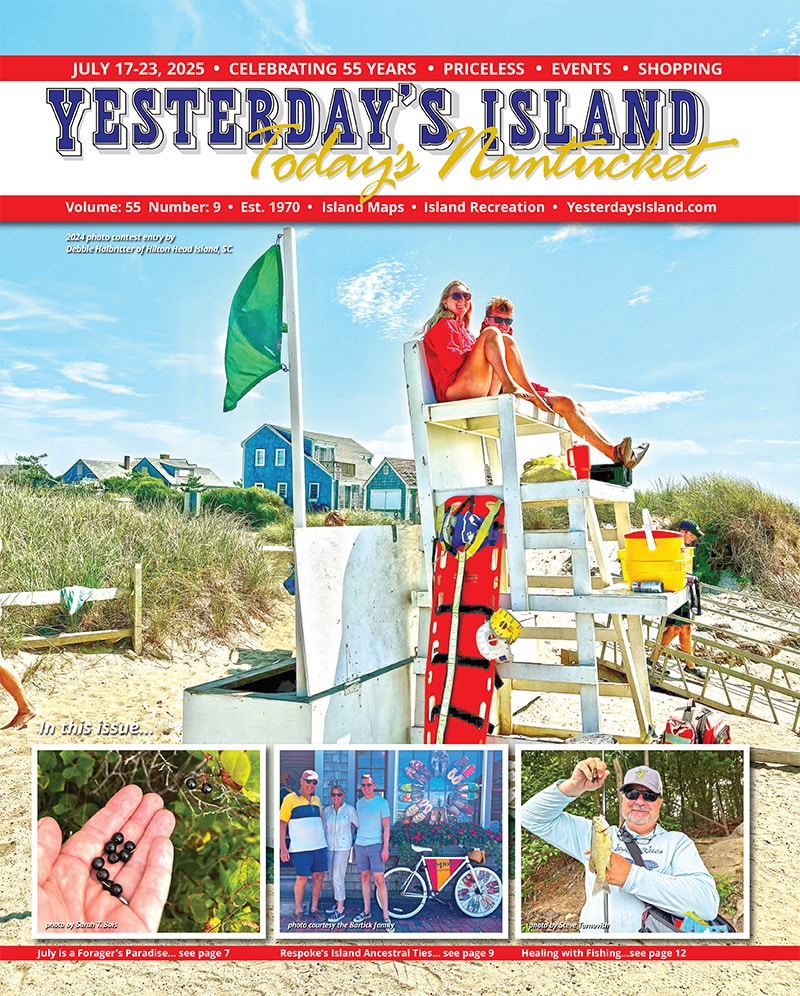by Dr. Sarah Treanor Bois, PhD
Director of Reseach & Education at the Linda Loring Nature Foundation
Sometimes finding a new species on the island is a welcome site; a new bird to add to a life list or a plant long forgotten and rediscovered. This is not one of those times, however. Unfortunately, but not surprising, Spotted Lantern Fly has now been found on Nantucket.
Spotted Lantern Fly (Lycorma delicatula or “SLF”) is an invasive insect originally from Asia that has been spreading throughout the northeastern US since it was first detected in Pennsylvania in 2014, coming from a shipment of stone. It has since spread to 14 states in New England and the mid-Atlantic, according to the U.S. Department of Agriculture.
As an adult, it is quite distinctive looking, making identification easy. Adult lanternflies resemble moths and are about one inch long, its gray top wings are black polka-dotted, as their name implies. They also have distinctive bright red spotted underwings making them easy to spot (no pun intended).
Professionals on-island both in conservation and in horticulture have been on the lookout for SLF for some time. As a tourist destination, with people and goods arriving from all over the world, especially from highly infested areas like New York and New Jersey, it seems like SLF’s arrival was inevitable. And now, a few individuals have been confirmed.
Last week, nymph stages of SLF were seen by crewmembers of Bartlett’s Tree Experts. Nantucket arborist Jim Cook alerted local conservation professionals about the find. With photo documentation, the sighting was verified and reported to the state. The Nantucket Invasive Plant Species Committee (IPSC) and other island conservation groups are working to help educate the public to be on the lookout. A few nymphs don’t make an official infestation, but they can obviously get here, so the more vigilant the community can be, the more likely we are to stave off an infestation.
Why are they so bad anyway? Spotted Lanternflies cause damage to trees and other woody plants by feeding on their sap. With an infestation, sucking the sap can reduce photosynthesis, weaken the plant, and eventually contribute to the plant’s death. While the primary host plant of SLF is the invasive tree-ofheaven (which we do have on Nantucket), researchers have found that it also targets grapevines, hops, blueberries, and fruit trees, giving it the potential to become a serious agricultural and ecological pest. The U.S. Department of Agriculture lists more than 100 other host plants.
Not only is their actual feeding harmful to the plants, but they produce “honeydew,” which is a sticky, sugary substance they excrete after eating. During an infestation, the honeydew can coat anything below the feeding insects, leaving plants, shrubs, cars, porches, bikes, everything coated in sticky sugar that ferments and stinks and can host mold. The honeydew also attracts other insects which can cause further damage to trees.
So how did they get here? According to Jennifer Forman Orth, an environmental biologist with the Massachusetts Department of Agricultural Resources, “We know they are associated with the transportation industry.” In other parts of the state, they have come in on shipments of pumpkins, mums, and other things that are shipped in in the fall, when adults are active in other states. We don’t know exactly how the insects came to Nantucket, but shipments of plants, gravel, and slate have been vectors in other areas. And we definitely ship a lot of goods fitting that description to the island.
In Massachusetts, the SLF was first reported in 2018 when a dead adult was found in a poinsettia plant. Individuals have now been found in 50 towns across the state with 4 outbreaks. SLF has been found on Martha’s Vineyard (Chilmark and Tisbury), but no infestation there yet. The state only considers a community to have an infestation when SLF are found active and with all life stages.
State officials ask for people to take photos, report, and, most importantly, to kill any insects found. Last year, New York and New Jersey had “See It Squish It” campaigns encouraging people to squash SLF on site joining their “Stomp Team.” Since they don’t cause any harm to people, squishing them is deemed a safe alternative to non-specific pesticide applications.
On Nantucket, we don’t yet have an infestation. Knowing what could happen, though, gives insight into why we want to be vigilant with spotting and squishing any seen.
The Spotted Lanternfly’s physical appearance transforms throughout its life stages as it matures to adulthood. The individuals that were found on Nantucket were one of the first instars (or nymphs): black with white spots. In infested areas, the nymphs often gather in large numbers on host plants, and at twilight can be easily found migrating up and down the trunk of the tree or plant. The nymphs look like black beetles with white spots on their back when they are young, but as they mature, they change colors to red and black backs with white spots. Nymphs often feed in tree canopies, but when they are blown or knocked out, they fall to the ground, walk to the trunk of trees and climb back up to start feeding again. They are clever concealers, and will also hide in vehicles, backpacks, backyard benches, firewood, bicycles, garden tools and a host of other common places. Look for the distinctive red shell coloring in the older nymphs and on the adult wings.
What to do? See it squish it! After photographing and reporting, of course. We want to know what, where, and when any individuals are seen. It’s important to check nursey stock where SLF could be hitchhiking. Also check shipments of stone, including flagstone, since we know they like to hide and potentially lay eggs there.
Another important step is knowledge. New information is constantly coming out as professionals in the northeast learn more about SLF in their new range. They may have gotten here accidentally, but experts now think that our warming climate could increase the species’ range and make explosions of the population harder to control or predict.
The state has extensive educational resources with tips for identification, what to do, maps, and more at mass.gov/spotted-lanternfly. There are education materials including coloring pages and origami to get the whole family engaged. IPSC and other island conservation groups are working to alert the public and to survey known populations of tree-of-heaven. With early detection, we hope to eradicate any individuals before Nantucket is infested with Spotted Lanternfly.
If you have questions about Spotted Lanternfly on Nantucket or want to report locally, please email Dr. Sarah Bois: stbois@llnf.org





